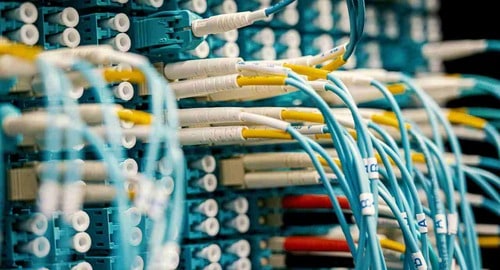
Do you know how data is transmitted through your internet connection? While most people rely on high-tech technologies like fiber optic cables to do amazing things like powering digital devices and enabling quick internet connectivity, only some understand how these complex systems work.
In this blog post, we’ll explore the intriguing world of fiber optics, providing a comprehensive overview of its inner workings so that you can better understand exactly what makes it such an essential technology today.
Introducing Fiber Optic Cables and their Benefits
Fiber optic cables are a game-changing transmission medium that harnesses the power of thin strands of glass or plastic to transmit data as pulses of light. Get ready to experience data transmission like never before!
Here are some key benefits of fiber optic cables:
High Bandwidth: Fiber optic cables are the superheroes of data transmission, boasting mind-boggling bandwidth levels that allow for lightning-fast and efficient transmission of large amounts of data. When it comes to data transfer rates, they leave traditional copper cables in the dust.
Longer distances: Fiber optic cables gracefully transmit data across vast spans while maintaining signal integrity. With minimal power loss, these marvels enable signals to travel for kilometers without the need for boosters.
Faster Speed: Fiber optic cables are the speed demons of data transmission, leaving copper cables behind. With the ability to transmit data at the speed of light, they slash latency and turbocharge download and upload times. Get ready for a data superhighway like no other!
Thinner and Lighter: Fiber optic cables, with their slim and lightweight design, outshine copper cables in more ways than one. Not only are they a breeze to handle and install, but they also take up minimal space in cabling infrastructure.
Greater Security: Fiber optic cables are the security heroes of data transmission! Unlike other cables, they don’t emit any electromagnetic signals that could be intercepted. With their tough-to-tap nature, they are the ultimate choice for safeguarding sensitive data and ensuring impeccable data integrity.
Fiber optic cables offer a multitude of advantages, making them the top choice for numerous applications. From telecommunications and internet connections to data centers and smart building infrastructure – they’ve got it all covered!
Structure of a Fiber Optic Cable
These incredible cables are made up of various components that work together seamlessly, ensuring efficient data transmission. Curious to know more? Here’s a breakdown of the basic structure:
Core:
At the heart of the fiber optic cable lies the core – a delicate strand of optically pure glass or plastic. It serves as the pathway through which light signals gracefully traverse. Enveloping the core is the cladding, providing a protective embrace. Together, they form the dynamic duo that powers the world of fiber optics.
Cladding:
Imagine the cladding as a protective shield embracing the core. With its lower refractive index, it works like a secret agent, ensuring that the light signals stay confined within the core. Say goodbye to signal loss caused by scattering!
Buffer Coating:
The buffer coating serves as a guardian, shielding the core and cladding from moisture, physical harm, and temperature fluctuations. Crafted from resilient plastic materials, it stands as a stalwart protector.
Strength Members:
Fiber optic cables are no ordinary cables. They’re fortified with strength members like aramid yarn or fiberglass, built right into their structure. These reinforcements give them the power to withstand stretching and breakage, making them super robust and reliable.
Outer Jacket:
The outer jacket of the fiber optic cable serves as a sturdy shield, safeguarding the entire cable assembly. It bravely withstands abrasion, moisture, chemicals, and other external elements. Crafted from durable materials like PVC (polyvinyl chloride) or LSZH (low smoke zero halogen) compounds, this jacket fearlessly protects the precious fibers within.
Understanding How Light is Transmitted Through Fiber Optic Cables
Experience the fascinating journey of light through fiber optic cables, guided by the mesmerizing principle of total internal reflection. As light enters the core, made of pristine glass or plastic, it transforms into tiny pulses or photons.
These vibrant messengers elegantly bounce off the core’s walls, embraced by the cladding with its lower refractive index.
The cladding acts as a guardian, keeping the light signals locked within the core. Picture a mirror-lined hallway, skillfully reflecting the light back into the core whenever it dares to escape.
This seamless dance of bouncing and reflection enables light to journey immense distances through the fiber optic cable, without losing its brilliance along the way.
Total internal reflection happens when the light hits the boundary between the core and cladding at an angle greater than the critical angle. This incredible phenomenon keeps the light waves bouncing inside the core, without escaping through refraction.
Consequently, the light pulses effortlessly travel through the fiber optic cable, minimizing signal loss and enabling rapid and efficient data transmission. Modulation, the art of transforming data bits into light pulses and vice versa, serves as the conduit for information across the fiber optic cable, unlocking a world of possibilities.
Identifying the Different Types of Fiber Optic Cables
From high-speed connections to long-distance transmissions, each type has its unique characteristics and applications.
Multimode Fiber (MMF): a marvel in optical communication
It carries multiple light rays simultaneously, thanks to its larger core diameter that provides various paths for light propagation.
Ideal for shorter distances and lower bandwidth applications, these fibers are easily recognized by their OM (optical mode) designation, followed by a number (OM1, OM2, OM3, OM4).
Curious to learn more? Dive into the specifications outlined by the ISO/IEC 11801 standard!
Single-Mode Fiber (SMF): the precision-engineered solution
With its smaller core diameter, it ensures straight-line light transmission, making it ideal for longer distances and high-bandwidth applications. Experience lower signal loss and higher data rates, surpassing the capabilities of multimode fibers.
Plastic Optical Fiber (POF): the affordable alternative
With a larger core diameter and cost-effective composition, POF is perfect for home networks and automotive applications.
Remember, each fiber optic cable has unique advantages and limitations. Choose wisely based on your specific requirements!
Applications of Fiber Optics in Everyday Life
Fiber optics are powering the connections that shape our world!
Communication Systems: From telephone networks to internet connections, fiber optics enable lightning-fast data transmission over long distances.
Medical Equipment: Doctors rely on fiber optics for precise imaging and minimally invasive procedures, providing a clearer view inside the human body.
Automotive Industry: Fiber optics drive innovation, enhancing lighting, sensor communication, and overall vehicle performance.
Surgery and Medical Imaging: Flexible fiber optic cables enable doctors to navigate and visualize the body with incredible precision.
Industrial Applications: Fiber optic sensors optimize manufacturing processes, improving safety, efficiency, and quality control.
Entertainment: Experience high-definition video, immersive audio, and stunning stage lighting, all made possible by fiber optics.
Security Systems: Fiber optic cables ensure secure and reliable transmission of video and data signals for robust surveillance systems.
Military and Aerospace: Lightweight and resistant to interference, fiber optics play a vital role in communication and data transmission in these industries.
Discover the versatility, speed, and reliability of fiber optics – the backbone of modern technology! With more and more applications finding uses for fiber optics, its importance will continue to grow.
The possibilities are limitless when it comes to the potential for fiber optic technology! From simple internet connectivity to life-saving medical equipment, this incredible tool has revolutionized our lives and industries.
And with new advances in fiber optics being made all the time, there’s no telling what could be around the corner!
AmeriFiber – Your Trusted Partner
AmeriFiber is dedicated to providing the highest quality fiber optics and related equipment, as well as top-notch customer support. Our relentless pursuit of innovation in this rapidly evolving field ensures that you consistently maximize the potential of your systems, empowering you with unparalleled performance and efficiency.
With AmeriFiber, you’re guaranteed reliability and innovation! Contact us today to explore your options and get the most out of your technology with AmeriFiber!
Our mission is to provide our customers with leading-edge fiber optics technology so that they can drive their vision forward.

Leave a Reply